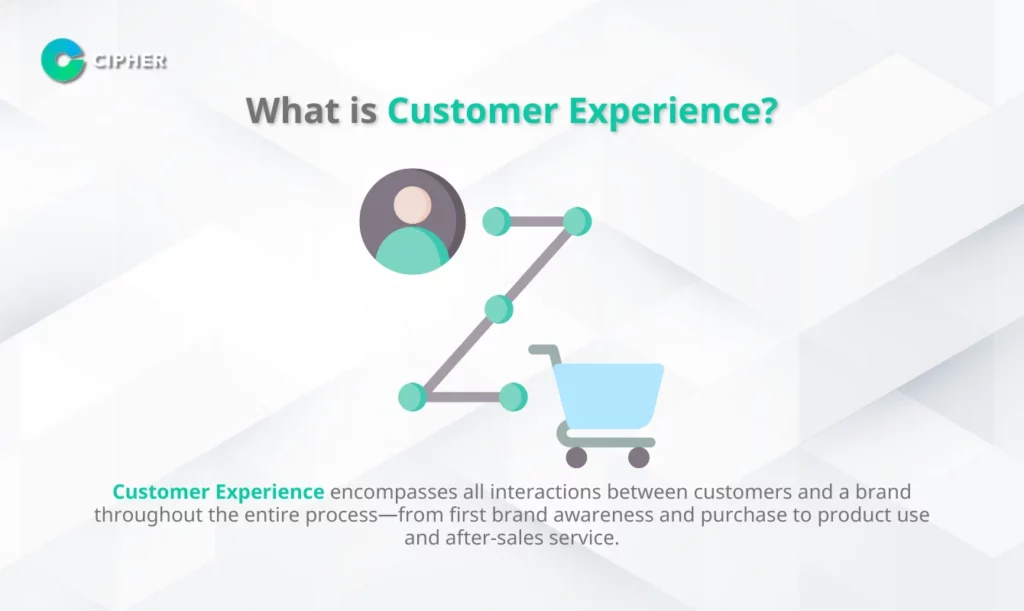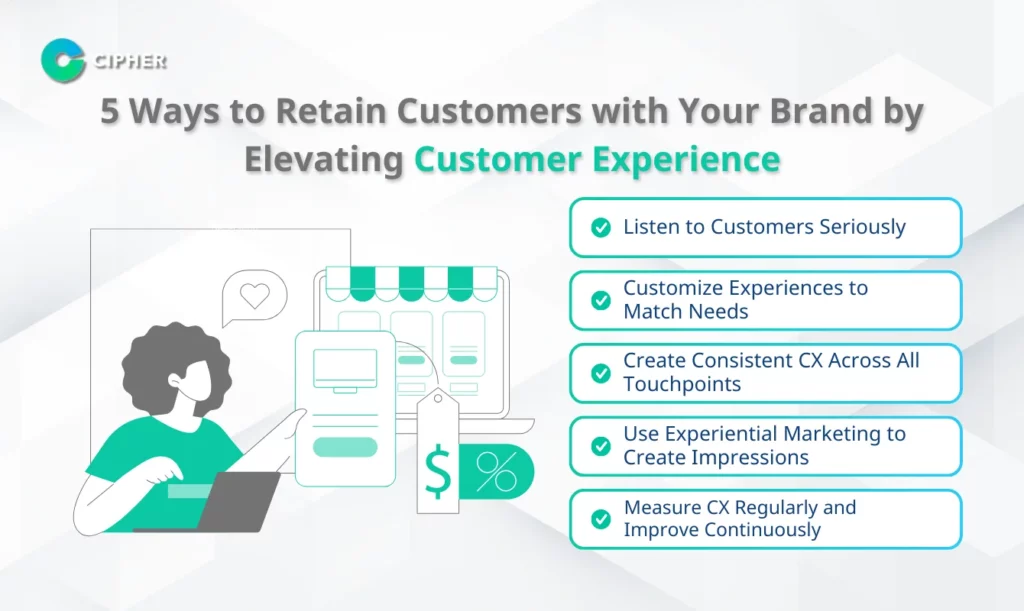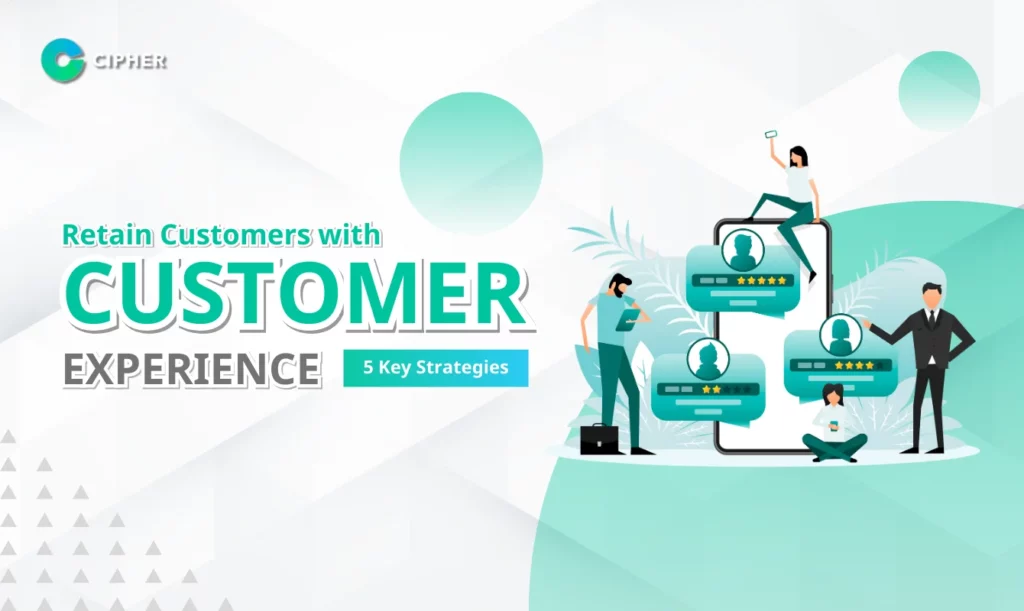Table of Contents
Retain Customers with Customer Experience: Everyone wants new customers flowing in while keeping existing ones from leaving. Certainly, what captivates customers goes beyond excellent products or outstanding services it’s about the “experience” customers receive at every touchpoint. In an era where everything is easily comparable, brands that understand and care about Customer Experience are the ones customers choose repeatedly.
At Cipher, we understand that the smallest customer feelings create significant results for your business. In this article, we’ll explore areas many businesses overlook, along with methods to develop Customer Experience into a sustainable customer retention strategy, creating differences competitors cannot replicate. We’ll also introduce our Social Media Marketing services that help address your business needs.
What is Customer Experience?

Customer Experience encompasses all interactions between customers and a brand throughout the entire process—from first brand awareness and purchase to product use and after-sales service. Customer Experience creates brand differentiation in an era where products and services are increasingly similar. It covers customers’ feelings, perceptions, and attitudes toward a brand at every touchpoint, whether online or offline.
Creating a positive customer experience means delivering impressive experiences at every stage of the Customer Journey. Customer Engagement is a crucial component that makes Customer Experience tangible and meaningful to customers.
Why Is Your Business Losing Customers? Examining Blind Spots in Customer Experience Issues
Many businesses mistakenly believe customers leave due to poor product quality or excessive pricing. In reality, most customer loss stems from unimpressive customer experiences whether it’s delayed responses, staff who don’t understand customer needs, or complicated systems. Retaining customers with Customer Experience should be every business’s top priority.
Not recognizing that Customer Experience is the heart of client retention causes many businesses to overlook small touchpoints that impact customer feelings. This blind spot leads customers to switch to competitors without your awareness. Understanding what aspects of Customer Experience affect customer decisions requires detailed business analysis and learning.
How Does Customer Experience Relate to Customer Retention?
Retaining customers with Customer Experience represents an inseparable relationship. When customers have positive experiences, they develop appreciation and are likely to make repeat purchases. Customers with good experiences have higher repurchase potential compared to those with negative experiences, making Customer Experience Marketing a vital tool for customer retention.
Effective customer experience management not only helps retain existing customers but also increases opportunities to acquire new ones through word-of-mouth referrals, as satisfied customers tend to recommend brands to others. Customer Experience Management is the systematic process that helps businesses manage customer experiences efficiently. This explains why leading businesses take Customer Experience Management seriously. Retaining customers with Customer Experience is therefore a worthwhile investment strategy.
What Are the Benefits of Retaining Customers with Customer Experience?
Focusing on customer experience isn’t just a trend but a strategy that delivers tangible business results. Customer Experience Management is a valuable investment for the following reasons:
- Long-term Brand Building:
Consistently good experiences build trust and connections between customers and brands, creating strong and sustainable brands. Good Customer Engagement forms the foundation for long-term success. - Reduced Churn Rate: Good Customer Experience reduces customer loss rates because customers have no reason to switch to competitors. Retaining customers with Customer Experience helps save costs in acquiring new customers.
- Increased Customer Lifetime Value: Impressed customers stay with brands longer and tend to spend more, resulting in higher customer lifetime value. Effective Customer Engagement stimulates repeat purchases.
- Customer Referrals:
Impressive experiences transform customers into brand ambassadors who bring new customers to your business. Customer Experience is a key mechanism for generating word-of-mouth marketing.
Components of Customer Experience That Affect Customer Loyalty
Continuous Interaction (Customer Engagement)
Customer Engagement is essential for creating good customer experiences. Regular interaction helps customers feel part of the brand and provides opportunities to listen to their genuine needs. Customer Engagement is the process of building deep relationships with customers. Customer Experience examples or simple ways to interact with customers include:
- Email: Sending personalized, useful emails at appropriate times helps create engagement and long-term connections. Customer Experience occurs when customers receive relevant and beneficial emails.
- Social Media: Social media platforms effectively create conversations, answer questions, and build relationships with customers. Retaining customers with Customer Experience on social media helps build strong communities.
- Chatbots or Call Centers: Fast and efficient support services solve problems and create positive impressions for customers. Customer Engagement through these channels makes customers feel cared for.
Customer Experience Management
Customer Experience Management is the systematic process of designing and managing customer experiences to ensure all touchpoints are aligned and create maximum satisfaction. Retaining customers with Customer Experience requires good management.
- Mapping Journey: Analyzing and designing the customer’s path (Customer Journey) to design a Customer Journey Map helps understand behaviors and needs at each stage. Customer Experience Management ensures that each journey point is consistent.
- Defining Touchpoints: Identifying all touchpoints between customers and brands and designing each to consistently create good experiences. Customer Experience is the sum of all touchpoints where customers interact.
- Measuring Satisfaction: Continuously tracking and evaluating customer satisfaction to use data for improvements and development. Customer Experience Management means continuous improvement based on received feedback.
5 Ways to Retain Customers with Your Brand by Elevating Customer Experience

1. Listen to Customers Seriously
Listening to customer opinions is fundamental to developing customer experience. Collecting data through feedback, surveys, and reviews helps understand true needs and expectations, as well as gaps requiring improvement.
- Net Promoter Score (NPS):
A customer loyalty measurement tool indicating how likely customers are to recommend your brand to others. - Post-purchase Survey: Post-purchase satisfaction surveys provide insights about buying and usage experiences.
- Feedback Channels: Opening convenient channels for customer feedback helps receive valuable suggestions and makes customers feel their opinions matter.
2. Customize Experiences to Match Needs
Using data for personalization helps present experiences aligned with individual customers’ preferences and behaviors. Creating individual customer experiences makes customers feel special and cared for.
- Recommendation System:
Systems recommending products or services appropriate to each customer’s interests and purchasing behaviors. - Using Names in Communication:
Addressing customers by name in communications creates familiarity and shows attentiveness. - Personalized Offers:
Presenting promotions or special privileges aligned with individual customers’ interests and behaviors.
3. Create Consistent CX Across All Touchpoints
Omnichannel Experience creates continuous and consistent experiences across all channels. Regardless of which channel customers use to contact your brand, they should receive unified and equally high-quality experiences.
- Website: User-friendly websites with complete information that quickly respond to customer needs.
- Mobile App: Applications with comprehensive functions, easy usability, and regular updates.
- Offline Store: Physical stores providing services matching online channel standards with connected information between channels.
- Customer Support:
Customer support teams understanding needs and providing quick, efficient service.
4. Use Experiential Marketing to Create Impressions
Experiential Marketing creates tangible experiences for customers. Letting customers “feel” real experiences builds strong and lasting emotional connections. When customers engage deeply with a brand, they feel connected and tend to be more loyal.
- Events: Organizing activities where customers participate and directly experience brand values.
- Workshops: Conducting practical training related to products or services, providing customers with useful knowledge and skills.
- Sampling / Demo: Letting customers try products or services before deciding to purchase helps build confidence and reduces decision-making risks.
5. Measure CX Regularly and Improve Continuously
Measuring with KPIs and making improvements are essential processes for continuous customer experience development. Regular data collection and outcome analysis reveal strengths and weaknesses requiring improvement to elevate Customer Experience.
- CSAT (Customer Satisfaction Score):
Customer satisfaction scores measuring service efficiency at each touchpoint. - CES (Customer Effort Score):
Tools measuring effort customers must expend to complete transactions or solve problems—lower is better. - CRM Dashboard: Real-time customer data tracking and analysis systems providing overviews and important trends.
Customer Experience Services from Cipher Team That Address Business Needs (Customer Experience Management)
The Cipher team specializes in Customer Experience Management and Social Media Marketing services, ready to elevate your business’s customer experience.
- Customer Journey Analysis: Detailed analysis of customer paths to identify important touchpoints and development opportunities.
- CX Strategy Design:
Creating customer experience management strategies aligned with business goals and values. - Feedback System Development: Designing and installing efficient feedback systems to obtain valuable insights.
- Staff Training: Enhancing understanding and skills for staff to deliver excellent customer experiences.
- Measurement and Improvement: Tracking results and providing recommendations for Social Media Management and continuous improvement.
Conclusion
Retaining customers with Customer Experience isn’t merely a temporary trend but a necessary strategy for businesses seeking long-term success. Experience is what makes customers remember brands and make repeat purchases. Creating outstanding customer experiences helps businesses differentiate from competitors and build strong loyalty. Customer Engagement and Customer Experience Management are key to successful customer retention.
If you want to elevate your business’s Customer Experience, the Cipher team is ready to help you strategize Social Media Management services and develop efficient customer experience management systems. Contact us today to begin your journey toward sustainable customer retention through superior Customer Experience.
Frequently Asked Questions About Retaining Customers with Customer Experience
How Does Customer Experience Differ from Customer Service?
Retaining customers with Customer Experience and Customer Service differ as follows:
- Customer Experience encompasses all interactions between customers and brands throughout the entire process, from first brand awareness to repeat purchases.
- Customer Service is just one component of Customer Experience, focusing specifically on providing service and solving problems when customers need assistance.
How Can Small Businesses Invest in Customer Experience with Limited Resources?
Small businesses can start by improving the most important touchpoints first, such as:
- Quick responses on online channels
- Training staff in good communication skills or simple customer satisfaction data collection
- Customer Experience means creating impressions at every touchpoint, which doesn’t necessarily require high budgets but needs attention to detail and consistency.
How Can You Measure the Success of Customer Experience Strategies?
Measuring Customer Experience success can be done through various methods, from:
- Using standard indicators like NPS (Net Promoter Score)
- CSAT (Customer Satisfaction Score) and CES (Customer Effort Score), to tracking customer retention rates
- Conversion rates and customer lifetime value





